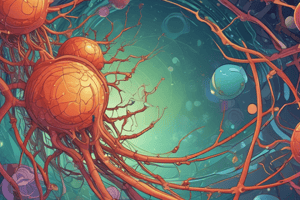Podcast
Questions and Answers
What is the main difference between innate and adaptive immunity?
What is the main difference between innate and adaptive immunity?
Which type of immunity involves the production of antibodies by B cells?
Which type of immunity involves the production of antibodies by B cells?
What is the result of a lack of or malfunctioning of the immune system?
What is the result of a lack of or malfunctioning of the immune system?
Which type of immunity is the first line of defense against infections?
Which type of immunity is the first line of defense against infections?
Signup and view all the answers
What is the characteristic of innate immunity that allows it to respond rapidly to infections?
What is the characteristic of innate immunity that allows it to respond rapidly to infections?
Signup and view all the answers
Which type of immunity is not discussed in the article?
Which type of immunity is not discussed in the article?
Signup and view all the answers
What is the outcome of active immunity?
What is the outcome of active immunity?
Signup and view all the answers
What is the characteristic of innate immunity?
What is the characteristic of innate immunity?
Signup and view all the answers
What is immunodeficiency?
What is immunodeficiency?
Signup and view all the answers
What is the result of passive immunity?
What is the result of passive immunity?
Signup and view all the answers
What is the relationship between innate and adaptive immunity?
What is the relationship between innate and adaptive immunity?
Signup and view all the answers
What is the outcome of active immunity in terms of future encounters with the same pathogen?
What is the outcome of active immunity in terms of future encounters with the same pathogen?
Signup and view all the answers
Study Notes
Introduction
The immune system is a network of cells, proteins, and organs that protect the body against infection and foreign substances. It has two main components: innate and adaptive immunity. In this article, we will discuss these two types of immunity, as well as immunodeficiency, passive immunity, and active immunity.
Innate Immunity
Innate immunity is the first line of defense against infections. It is non-specific and does not rely on the recognition of specific pathogens. Instead, it uses a variety of cells, including phagocytes, mast cells, basophils, and eosinophils, as well as the complement system, to recognize and eliminate foreign substances. Innate immunity is rapid and occurs minutes or hours after exposure to a pathogen. It does not have immunologic memory, meaning it cannot recognize or remember the same pathogen upon future exposure.
Adaptive Immunity
Adaptive immunity is the second line of defense and develops in conjunction with innate immunity. It is antigen-specific and requires the recognition of specific pathogens. Adaptive immunity involves T cells, antigen-presenting cells (APCs), and B cells. T cells are activated by APCs and proliferate, while B cells differentiate into plasma cells and produce antibodies. Adaptive immunity has a lag time between exposure to an antigen and a maximal response. It is characterized by the development of immunologic memory, allowing for a more rapid and efficient immune response upon subsequent exposure to the same pathogen.
Immunodeficiency
Immunodeficiency refers to a weakened immune system. This can be due to various factors, including genetics, disease, or the use of certain medications. Individuals with immunodeficiency are more susceptible to infections and may have difficulty fighting off pathogens.
Passive Immunity
Passive immunity is the transfer of pre-formed antibodies from one individual to another. This can occur through breastfeeding, maternal antibodies, or the administration of antibodies through a vaccine or immunoglobulin therapy. Passive immunity provides immediate protection but does not last long and does not develop immunologic memory.
Active Immunity
Active immunity is the development of an individual's own immune response to a pathogen. This can occur through natural infection or vaccination. Active immunity provides long-lasting protection and the development of immunologic memory. The immune system "learns" to recognize and respond more efficiently to future encounters with the same pathogen.
In conclusion, the immune system is a complex network of cells, proteins, and organs that protect the body against infection and foreign substances. It is made up of innate and adaptive immunity, which work together to provide effective host defense. Immunodeficiency, passive immunity, and active immunity are all important aspects of the immune system, each providing different levels of protection and responses to pathogens. Understanding these aspects of immunity is crucial for maintaining a healthy immune system and preventing the spread of infections.
Studying That Suits You
Use AI to generate personalized quizzes and flashcards to suit your learning preferences.
Description
Learn about the immune system's two main components: innate and adaptive immunity, as well as immunodeficiency, passive immunity, and active immunity. Understand how the immune system protects the body against infection and foreign substances.




